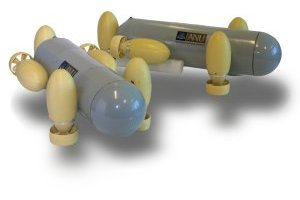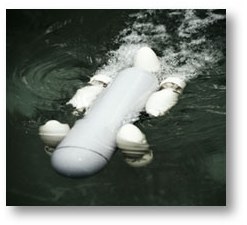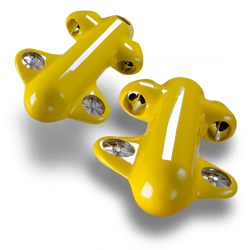

Research

 |

Research |
 |
|
Current occupationI am currently a Visiting Fellow at the College for Engineering and Computer Science (CECS) at the Australian National University in Canberra, and I am also a lecturer for the course Concurrent and Distributed Systems this semester. My current research involves various aspects of aerial robotics, haptic feedback, inertial and visual guidance for teleoperation of flying vehicles.Research interestsMy main research interests are in the area of mobile robotics, and the computer science aspects of robotics. I am currently working on haptic user-machine interfaces, visual sensing for flying vehicles, semi-autonomous flight control and pilot assistance systems for teleoperation. Other interests include unsupervised machine learning (deriving spatio-temporal structure from unmodelled data), underwater communication channels, ad hoc networking, and applications of robotic swarms. I have experience in underwater robotics, underwater communication, computer vision, time series analysis and spatio-temporal mapping, machine learning, real-time programming and embedded systems. Previous research was on adhoc multi-hop wireless networks for swarms of submersibles. This involves low-level hardware development, (longwave radio modules and an optical transceivers), but also higher-level collision free time-sliced sender-arbitration protocols. Of special interest is the theoretical impications of Omnicast (many-to-many) communication, and how it can be efficiently implemented.I am trying to bridge the gap between theory and praxis, evaluating theoretical findings in physical experiments, and being inspired by their outcome. This involves design and implementation of electronic and mechanical hardware and software systems. Previous researchI completed my PhD at the Australian National University in Canberra (ANU), Research School of Information Sciences and Engineering, on mobile autonomous robots, especially autonomous underwater vehicles (AUVs). The project is called Serafina. The goal of the project is to develop a swarm of small autonomous submersibles. Please have a look at the project website for details. 


Why underwater robotics is interestingThe underwater environment offers 6 degrees of freedom in movement, complex dynamics, and a mostly unexplored test arena the size of a planet (well, three quarters of it, anyway...). From a research point of view, lots of challenges everywhere!.The Serafina AUV is extremely suitable to face real-world experiments. It is relatively light, small, and robust - a possible collision does basically no harm to neither the robot, nor the environment. This opens up possiblities for adaptive learning on real platforms. With five degrees of freedom, it is also very agile. Due to its small size, it can move freely in the limited space of a small pool, which simplifies experiments a lot. Many challenges in the project also arise on the hardware side. Most established land-based sensing and communication methods don't work under water. An example: Basically all wireless data transceivers operate in the high MHz or GHz range, also known as Microwaves. Water perfectly absorbs microwaves (this is how a microwave oven works). This basically reduces the communication range to a few millimeters. We have developed a longwave radio system to circumvent these problems. One other constraint is the limited space - most commercially available sonar sensors, for example, are 3 times bigger and 5 times more expensive than our submersible. To make it short, this is a very challenging and extremely interesting project with enormous potential! PublicationsPapersA New Framework for Force Feedback Teleoperation of Robotic Vehicles based on Optical Flow. (pdf, 416kb) Robert Mahony, Felix Schill, Peter Corke and Yoong Siang Oh. To appear in Proceedings of IEEE International Conference on Robotics and Automation (ICRA) 2009. Complex Control Skills Acquisition Supported by Haptic Feedback (pdf, 2.1Mb) Felix Schill and Uwe R. Zimmer Proceedings of the 2008 Australasian Conference on Robotics and Automation (ACRA '08), December 2008, Canberra, Australia Virtual force feedback teleoperation of the InsectBot using optic flow. (pdf, 688kb) Felix Schill, Robert Mahhony, Peter Corke and Luke Cole, Proceedings of Australasian Conference on Robotics and Automation (ACRA) 2008. Pruning Local Schedules for Efficient Swarm Communication (PDF, 1.5Mb) Felix Schill and Uwe R. Zimmer, Proceedings of the International Symposium on Underwater Technology, Tokyo, Japan, 2007 A communication module and TDMA scheduling for a swarm of small submarines, Ram Somaraju and Felix Schill, Tr. J. of Electrical Engineering and Computer Sciences, Special Issue on Swarm Robotics, 2007. "Effective Communication in Schools of Submersibles" (PDF, 1.2Mbyte) Felix Schill, Uwe R. Zimmer, Proc. IEEE OCEANS 2006. "Distributed Dynamical Omnicast Routing" Felix Schill and Uwe R. Zimmer, Complex Systems (intl. Journal), 2006, 16, 299-316. "Towards Optimal TDMA Scheduling for Robotic Swarm Communication" (PDF, 518 kB) Felix Schill, Uwe R. Zimmer, Jochen Trumpf, Proc. TAROS 2005. "Visible Spectrum Optical Communication and Distance Sensing for Underwater Applications" (pdf, 184 kb) Felix Schill, Uwe R. Zimmer, Jochen Trumpf, Proc. ACRA 2004 "Robust Asynchronous Temporal Event Mapping" (pdf, 140 kb) (Felix Schill, Uwe R. Zimmer, Proc. IROS 2002. ThesesDistributed Communication in Swarms of Autonomous Underwater VehiclesFelix Schill, PhD Thesis. Submitted and accepted at The Australian National University. July 2007. Download PDF (3.5Mb) "Distributed Temporal Event Mapping and Fusion" Diplomarbeit (diploma thesis), Universität Karlsruhe, 2003. Abstract (pdf, 26kb) Diploma thesis (pdf, 1.2 Mb) "Java-basierte 3D-Objekterkennung aus Stereobildern" Studienarbeit (thesis), Universität Karlsruhe, 2001. Ausarbeitung (ps.gz, 794 kB) Ausarbeitung (pdf, 700 kB) Related paper: Recognizing Objects by Matching Oriented Points Data sets of Serafina test runs...Other material related to computer science...
|